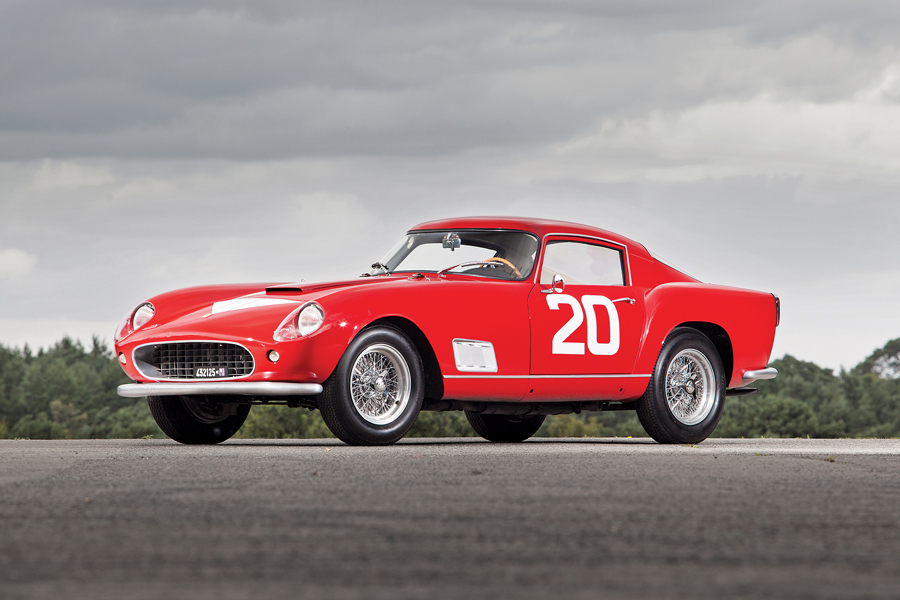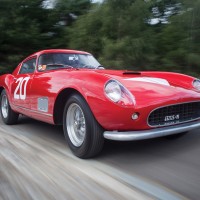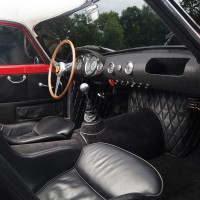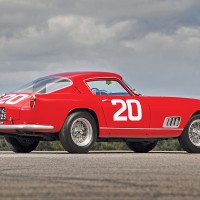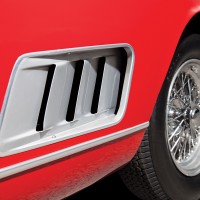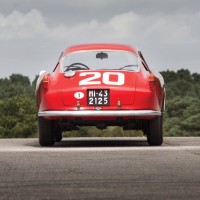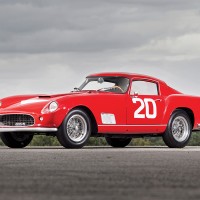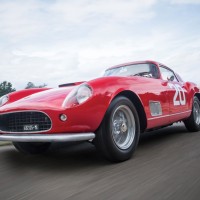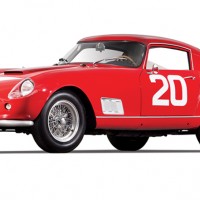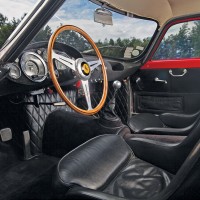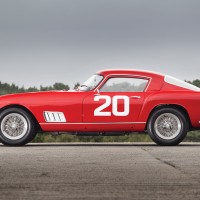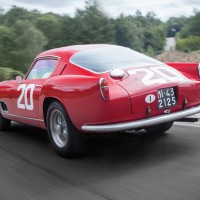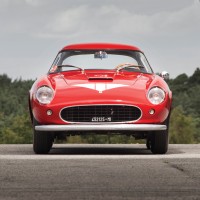SCM Analysis
Detailing
| Vehicle: | 1958 Ferrari 250 GT Berlinetta Competizione TdF |
| Years Produced: | 1956–59 |
| Number Produced: | 77 |
| Original List Price: | $12,000 |
| SCM Valuation: | $6,500,000–$11,500,000 |
| Tune Up Cost: | $3,000 |
| Distributor Caps: | $450 |
| Chassis Number Location: | Left frame member by steering box |
| Engine Number Location: | Right rear motor mount |
| Club Info: | Ferrari Club of America |
| Website: | http://www.ferrariclubofamerica.org |
| Alternatives: | 1958 Mercedes-Benz 300SL, 1958 Ferrari California Spyder, 1960–63 Aston Martin DB4GT Zagato, 1953–55 Jaguar D-type |
| Investment Grade: | A |
This car, Lot 172, sold for $7,667,319, including buyer’s premium, at RM Sotheby’s London Auction on September 7, 2015.
The majority of international four-wheel racing is regulated by the Federation Internationale de Automobile commonly known as the FIA. The FIA makes rules that are adopted by automobile clubs throughout the world. The organization currently comprises 237 organizations in 132 countries. The FIA governs racing at all levels of racing, from amateur to professional, from Karting to Formula One.
A tragic accident at the 1955 24 Hour Le Mans race saw 83 spectators and a driver die — plus another 120 spectators injured. It was the worst accident in the history of motor racing and correspondingly drew severe condemnation of the sport.
Partly in response to the disaster, 1956 FIA rules introduced a new, production-based GT class with cars classed according to their displacement.
The two- to three-liter GT class was a perfect fit for Ferrari’s 3-liter 250 engine, and over the next 10 years the class would be dominated by a series of Ferrari 250 GT models. The Ferraris won prestigious international endurance races, multi-stage Mille Miglia style races, hillclimbs, and small-venue club races. Anywhere GT cars raced you would find Ferraris, and everywhere they raced, they dominated.
Ferrari’s most famous name
The name 250 GT covers a lot of territory. Ferrari called many different cars 250 GTs. In rough terms, a 250 GT is a Grand Touring car rather than an all-out race car. Variations of 250 GTs were produced from 1952 through 1964. They can be open top, closed top, two passenger or four passenger. They can lean towards a serious race car, a dual-purpose race/street car, or a high-performance street car.
The use of a common name in part might be credited to desiring latitude on homologation papers. If your new car was named the same as your old car, you might get a pass on a modification that a newly named car wouldn’t. Additionally, a modifier such as “long wheelbase” wasn’t needed if a short-wheelbase model hadn’t been introduced yet. The names we call many Ferraris today are nicknames that Ferrari never officially recognized, but they became necessary and common.
Ferrari built race cars before he built street cars. All early Ferraris were based on racing engineering. All vintage street Ferraris evolved from race cars. No vintage Ferrari race car evolved from a street car.
The 250 GTs were no exception. As direct descendants of the 250 Mille Miglia, all 250 GTs had a legitimate racing heritage. One line of 250 GTs would extend their heritage to become a racing icon.
The FIA GT class was designed for production-based cars, so Ferrari designed a car for the class. The 250 Gran Turismo Berlinetta was Ferrari’s answer to the challenge.
The Berlinetta — light coupe — was what would be called a dual-purpose car. It was engineered to be a race car that was just civilized and dependable enough to also be driven on the street.
Between 1955 and 1964, Ferrari would build roughly 300 dual-purpose 250 Berlinettas. The run would include the 250 GT Long-Wheelbase Berlinetta, the 250 Short-Wheelbase Berlinetta, the 250 GTO and a few interim cars.
The TdF appears
The early 250 GT Berlinettas are alternately known as Long-Wheelbase models or Tour de Frances. The Tour de France was a grueling multi-stage, multi-day event consisting of multiple circuit races, a couple of hillclimbs and maybe a drag race, all interspersed within a high-speed rally. The event was so tough that in 1963 only 31 of the 122 starters finished. That year a 250 GTO took top honors. The name “Tour de France” was bestowed on the Long-Wheelbase Berlinetta after winning the 1956 race. It was a fitting title, as 250 GTs won their class at the Tour nine years straight.
Not all TdFs are equal. There were several different versions of the TdF — with some subsets. While the chief differentiating factor — the number of louvers in the sail panel behind the side window — significantly influences value, other criteria, such as body builder, open or closed headlight, Mille Miglia retrospective eligibility, and racing history are also important factors.
Some are better than others
Evaluating RM Sotheby’s TdF 0897 is a little like judging the Miss America Pageant. They’re all winners, but some are better than others.
Chassis 0897 is a wonderful car with a good provenance, but it isn’t a top-shelf TdF. It is a single-louver model, which is not the most desirable TdF combination. It has been enjoyed hard, and it is not in show condition.
More importantly, chassis 0897 had a couple good finishes in a couple of minor races, but no major successes.
Following RM Sotheby’s $13,200,200 TdF sale at Monterey this year (November 2015, p. 114), a sale price of $7,667,319 might seem like the sky is falling. On the contrary, the bid was probably spot-on.
The $13.2 million car was the very 250 TdF that won the 1956 Tour de France — and earned the nomenclature for the model. It was owned and raced by Alfonso de Portago, the Marquis de Portago, an important Ferrari patron and an important TdF pilot. This car was a once-in-a-lifetime opportunity, and the final bid was fitting for the prize.
Our subject car, chassis 0897, achieved a solid result appropriate to the car. Lest we forget, $7.7 million puts it in rarified air shared by only a few cars on the planet. Chassis 0897 may not have rung the TdF bell, but both sides should have gone home happy. ♦
(Introductory description courtesy of RM Sotheby’s.)
